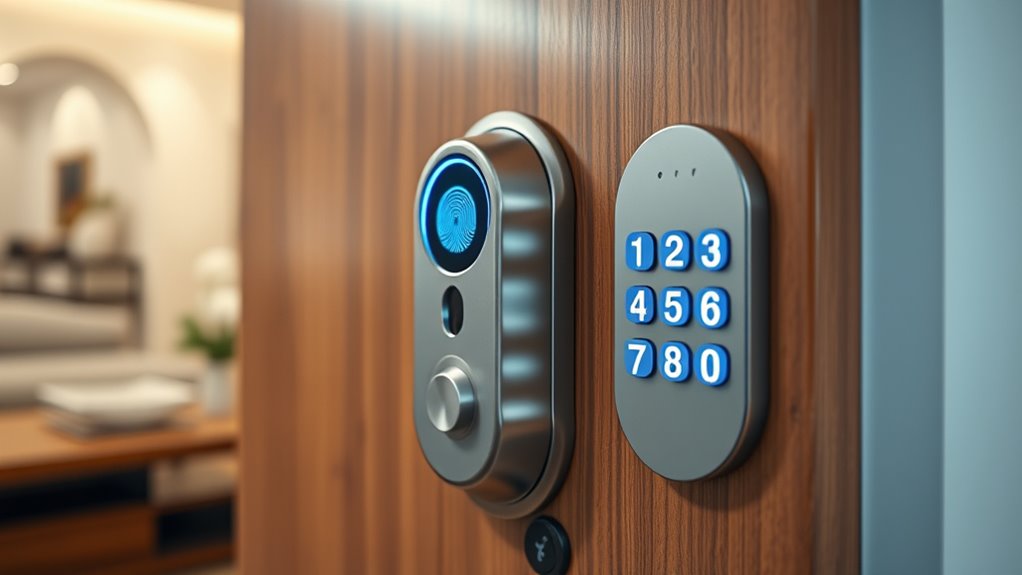When choosing between biometric and PIN smart locks, biometrics tend to be safer because they rely on unique biological traits like fingerprints or facial features, making them harder to fake. PINs are affordable and easy to change but can be observed or guessed. Both options have their benefits, but understanding their strengths can help you pick what suits your security needs best. Keep exploring to discover how each option can protect your home effectively.
Key Takeaways
- Biometrics are generally safer due to their difficulty to falsify compared to PINs.
- PINs can be compromised if observed; biometrics rely on unique, hard-to-replicate traits.
- Biometrics offer quick, contactless access, reducing physical contact risks.
- PIN security depends on choosing strong, unique codes and regular updates.
- Both methods provide secure options; choice depends on security needs, convenience, and budget.

Smart Locks 2.0 are revolutionizing home security by combining advanced technology with user-friendly features. These smart locks give you more control and flexibility than traditional locks, making your home safer and more convenient. One key advantage is the way they handle emergency access and user convenience. Whether you’re locked out or need to grant quick access to a trusted visitor, these locks offer quick, secure solutions that traditional keys can’t match. With features like biometric scans and PIN codes, you get a seamless experience that prioritizes both safety and ease of use.
Smart Locks 2.0 enhance security with quick, secure access options like biometrics and PINs for ultimate convenience.
When it comes to emergency access, smart locks excel because they provide multiple options for entry. If you lose your phone or forget your PIN, you can often use backup methods like biometric authentication or a physical key. Some models even offer remote unlocking via smartphone apps, so you can open the door for emergency responders or friends without physically being there. This flexibility guarantees that in urgent situations, you’re never truly locked out or unable to provide access. It’s a major upgrade from traditional locks, which typically rely on a single key that can be lost or stolen, creating vulnerabilities during emergencies.
User convenience is another reason smart locks are gaining popularity. You don’t have to carry around a bulky keychain or worry about losing keys anymore. Instead, you can unlock your door with a fingerprint or a PIN, which you can change anytime you’d like. This feature is especially useful when you have multiple people coming and going—family members, service providers, or guests—since you can easily grant or revoke access without changing physical locks. Plus, many smart locks integrate with your smartphone, allowing you to monitor access logs, receive alerts when someone enters, and even lock or unlock remotely. All these features make managing your home security effortless and intuitive.
Choosing between biometric and PIN-based smart locks depends on your priorities. Biometric locks, which use fingerprint or facial recognition, are often considered safer because they rely on unique biological traits that are hard to falsify. They also offer quick access, which is ideal in emergency situations. However, they can be more expensive and sometimes less reliable if your fingerprint is wet or dirty. PIN-based locks are generally more affordable and still provide a high level of security. You can change your PIN regularly to prevent unauthorized access, and they don’t require specialized hardware. But, if someone observes your PIN, they could potentially gain entry, so privacy and discretion are important.
Frequently Asked Questions
Can Biometric Locks Be Hacked Remotely?
You might wonder if biometric locks can be hacked remotely. While they use encryption security to protect your data, sophisticated cybercriminals can attempt remote hacking. However, biometric systems are generally more secure because they rely on unique physical traits, making remote hacking more difficult compared to traditional methods. Still, it’s essential to keep your device software updated and use strong network security to minimize risks.
What Is the Lifespan of a PIN Code?
Imagine your PIN as a loyal, aging pet—its lifespan depends on how well you care for it. Typically, PIN durability varies, with lifespan estimation around 1 to 3 years before you might need to change it due to wear or security concerns. Regular updates and strong, unique codes help extend its usefulness. So, stay vigilant and treat your PIN like a treasured companion—update it to keep your home safe.
Are Biometric Locks Vulnerable to Physical Damage?
You might wonder if biometric locks are vulnerable to physical damage. While they rely on hardware durability, their sensors can be sensitive to scratches or impacts, making them physically susceptible. However, many models are designed with sturdy materials to reduce this risk. Still, you should handle them carefully and avoid harsh impacts, as damage to the sensor could impair functionality. Proper maintenance ensures your biometric lock stays reliable and secure.
How Do I Update or Change My PIN?
Did you know that over 60% of users rarely update their PINs? To change or update your PIN, first access your lock’s app or keypad. Follow the security protocols, usually involving entering your current PIN first. Then, select PIN customization, and input your new code. Make sure it’s strong and unique to enhance security. Regular updates keep your lock protected against unauthorized access.
Do Biometric Systems Store Fingerprint Data Securely?
You might wonder if biometric systems handle your fingerprint data securely. Rest assured, fingerprint encryption protects your biometric data, transforming it into a secure code that can’t be easily accessed. Data storage security measures, like local storage on your device or encrypted cloud storage, help prevent unauthorized access. So, your fingerprint info is stored safely, making biometric systems a reliable and secure way to manage access.
Conclusion
Ultimately, choosing between biometric and PIN smart locks is like picking the right key for your door—each has its strengths and vulnerabilities. I once heard of someone who trusted a fingerprint lock only to find their pet’s paw could open it. Data shows biometrics are secure but not foolproof, while PINs can be forgotten or cracked. Think of it as a lock and key—trust your instincts, but remember, even the strongest lock isn’t invincible.









